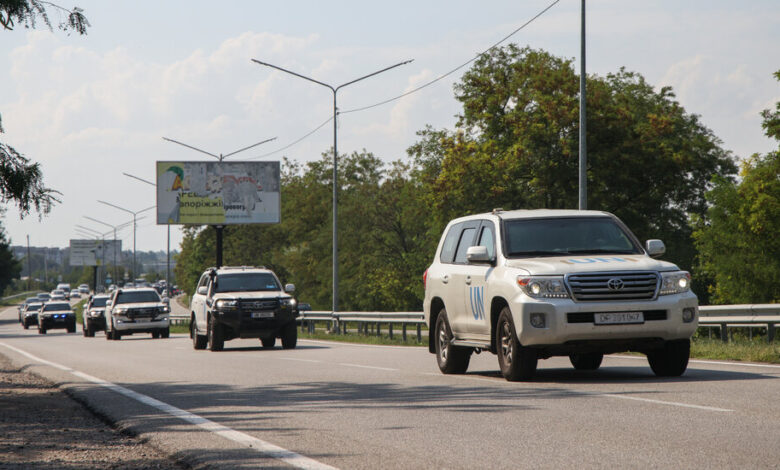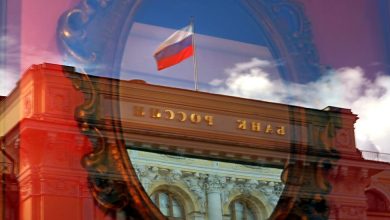U.N. Experts Plan Perilous Visit to Ukrainian Nuclear Plant Thursday

ZAPORIZHZHIA, Ukraine — An international team of nuclear experts on Wednesday approached the combat zone in Russia’s war on Ukraine, preparing to cross over the front lines on Thursday to inspect the imperiled, Russian-occupied Zaporizhzhia Nuclear Power Plant, in one of the most complex and perilous missions of its kind ever attempted.
The group of 14 experts with the International Atomic Energy Agency, the United Nations’ nuclear watchdog, left Kyiv, the Ukrainian capital, in a convoy of armored S.U.V.s and traveled south, stopping for the night in the Ukrainian-held city of Zaporizhzhia, within range of Russian guns. Reaching the plant, about 30 miles to the southwest, will entail crossing a buffer zone between the two armies of battered villages and fields cratered by artillery shells.
Russian officials have said they welcome both the inspection by independent nuclear scientists trying to gauge the state of the plant and its staff, and an I.A.E.A. plan to establish a permanent presence there. But the Russian commitment to transparency remains unclear.
The I.A.E.A. director general, Rafael M. Grossi, said Wednesday that he hoped to spend “several days” at the site in southern Ukraine, but local officials aligned with the Russian army suggested a more abbreviated visit of one day. In addition, a Russian official said the nuclear inspectors would not be waved through checkpoints, but would have to wait along with other civilian traffic, further limiting their time at the site.
For the first time in history, an active battlefield encompasses a nuclear plant, and frequent shelling has raised fears of a catastrophic radiation release. Parts of the sprawling Zaporizhzhia complex, Europe’s largest nuclear power station, have been hit by artillery and bullets, so far without disastrous results, and each side has blamed the other, accusing the enemy of risking an international calamity to gain leverage.
The inspection mission coincides with a Ukrainian push, primarily in the Kherson and Mykolaiv regions farther to the southwest, to retake territory seized by Russian forces soon after they invaded on Feb. 24. The Ukrainian military said it had struck Russian command posts and logistical sites on Wednesday.
A British intelligence report said that Ukraine had “pushed the front line back some distance in places, exploiting relatively thinly held Russian defenses,” while Russia’s Defense Ministry said that its forces had repulsed Ukrainian attacks. Military analysts have questioned whether Ukraine has the resources to mount and sustain a major counteroffensive.
Both Russia, whose forces seized the Zaporizhzhia plant on the Dnipro River shortly after invading, and Ukraine, whose military holds positions only a few miles away on the opposite bank, say they support the I.A.E.A. mission. But they have disagreed on how it should be carried out. Each country wanted the inspectors to approach through territory it controls, and Russian officials have ignored pleas to withdraw from the facility to create a demilitarized zone around it.
Ukrainian workers have continued operating the plant under harsh conditions.
In brief comments to reporters, Mr. Grossi did not address specific challenges but said his team included “very experienced people, the best and the brightest,” who would provide the world the first impartial view of the risks posed by combat to the station’s six nuclear reactors and radioactive waste storage sites.
“We will have a pretty good idea of what is going on,” he said. Of the visit, he said, “it is a mission that seeks to prevent a nuclear accident.”
But it was unclear how much time the inspectors would be able to spend at the plant. Vladimir Rogov, an official in the Russian army’s occupation administration in the area, said on Wednesday that the I.A.E.A. team would have to wait in line at frontline checkpoints.
“They will not be provided with a special pass,” he said. “They had a chance to come from Russia through the liberated territory safely, quickly and without obstacles.”
The Kremlin-appointed chief of the Zaporizhzhia region, Yevhen Balytskyi, said the visit was expected to last only one day, calling the delegation’s goal vague.
“They have one day to inspect the operation of the plant,” he said, adding, “If they say some elements need to be attended to, we’ll be able to do so.”
Mikhail Ulyanov, Moscow’s envoy to the I.A.E.A, wrote in a tweet that Russia “welcomes” the agency’s objective of setting up a permanent presence for international inspectors at the plant, but that it remained unclear when such a mission would begin.
Russian troops seized the Chernobyl nuclear plant, in northern Ukraine, early in the war, but later withdrew. While there, Ukrainians said, the Russians took heedless risks, including with their own safety, digging into soil that remains radioactive from the 1986 accident there.
Fighting in and around the Zaporizhzhia plant has sprayed one reactor containment vessel with shrapnel, penetrated a reactor building with a large caliber bullet, blown out windows in an administrative building, ignited fires in a training facility, destroyed a fire station and left holes in the roof of a building from artillery strikes.
In what President Volodymyr Zelensky characterized as the closest call yet, fighting in August severed an electrical line, cutting off two active nuclear reactors from a source of power to run vital cooling pumps and control equipment. Emergency diesel generators supplied power until the line was repaired, but the incident raised what experts call the worst scenario of all — a cooling system failure that could lead one or more reactor cores to melt down.
Overnight Tuesday to Wednesday, as the I.A.E.A. team prepared to depart from Kyiv, artillery barrages struck the adjoining town that is home to plant employees and their families, Enerhodar, which means “the gift of energy,” Ukrainian officials said.
Ukrainian officials said the Russian army had struck the town to unnerve the visiting nuclear scientists and “form a pool of local residents” who would confront the I.A.E.A. team about the combat damage when it arrived for the inspection. Across the Dnipro River, in the Ukrainian-controlled town of Nikopol, rocket artillery strikes overnight wounded one woman, authorities said.
Mr. Grossi said his agency, which oversees only nuclear safety, would make no assessment of the chaotic swirl of combat activity around the nuclear plant.
Ukrainian officials have accused the Russian army of ensconcing itself in the plant to forestall a Ukrainian counteroffensive, essentially threatening a nuclear disaster if the Ukrainian army tries to push past the site.
“They are Russians,” Oleksiy Danilov, the secretary of Ukraine’s national security council, said in an interview Wednesday. “Nuclear terrorism for them is like for us, breakfast.”
Ukrainian officials are distributing iodine pills to protect people living near the Zaporizhzhia facility from radiation-induced thyroid cancer in case of a crisis at the plant. At a hospital in the Khortytsia district of Zaporizhzhia city, Dr. Sveta Kovalenko, 51, handed out pills to a steady stream of families.
One woman, Olga Stepanenko, 64, was getting some for her grandchildren.
“You need to hope that there will not be a nuclear disaster,” she said. “But always be prepared for the worst.”
Marc Santora contributed reporting from Kyiv, Ukraine, and Oleksandr Chubko from Zaporizhzhia, Ukraine.




